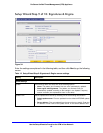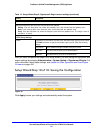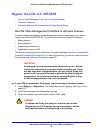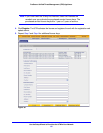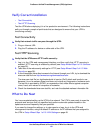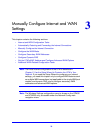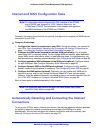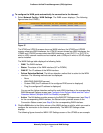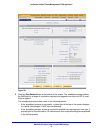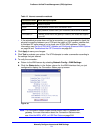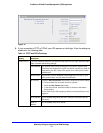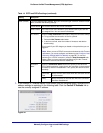
Manually Configure Internet and WAN Settings
71
ProSecure Unified Threat Management (UTM) Appliance
Internet and WAN Configuration Tasks
Note: For information about configuring the DSL interface of the UTM9S
and UTM25S, see Appendix A, xDSL Network Module for the
UTM9S and UTM25S. The information in this chapter also applies to
the WAN interfaces of the UTM9S and UTM25S.
Generally, five steps, three of which are optional, are required to complete the WAN Internet
connection of your UTM.
Complete these steps:
1. Configure the Internet connections to your ISPs. During this phase, you connect to
your ISPs. See Automatically Detecting and Connecting the Internet Connections on
page 71 or Manually Configure the Internet Connection on page 75.
2. Configure the WAN mode (required for multiple WAN port models). For all models,
select either NAT or classical routing. For the multiple WAN port models, select dedicated
(single WAN) mode, auto-rollover mode, or load balancing mode. For load balancing, you
can also select any necessary protocol bindings. See Configure the WAN Mode on page 80.
3. Configure secondary WAN addresses on the WAN ports (optional). Configure aliases
for each WAN port. See Configure Secondary WAN Addresses on page 89.
4. Configure Dynamic DNS on the WAN ports (optional). Configure your fully qualified
domain names during this phase (if necessary). See Configure Dynamic DNS on page 91.
5. Configure the WAN options (optional). Optionally, you can enable each WAN port to
respond to a ping, and you can change the factory default MTU size and port speed.
However, these are advanced features, and changing them is not usually required. See Set
the UTM’s MAC Address and Configure Advanced WAN Options on page 94.
Each of these tasks is detailed separately in this chapter.
Note: For information about how to configure the WAN meters, see Enable
the WAN Traffic Meter on page 462.
Automatically Detecting and Connecting the Internet
Connections
To set up your UTM for secure Internet connections, the web management interface provides
the option to detect the network connections and configure the WAN port or ports
automatically. You can also configure the Internet connections and ports manually (see
Manually Configure the Internet Connection on page 75).



